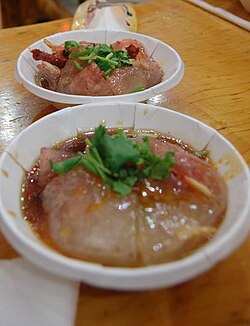Ba-wan
This article includes a list of general references, but it remains largely unverified because it lacks sufficient corresponding inline citations. (March 2016) |
 | |
| Type | Dumpling |
|---|---|
| Course | Dim sum |
| Place of origin | Taiwan |
| Main ingredients | Dough (corn starch, sweet potato starch, rice flour), pork, chicken, bamboo shoots, shiitake mushrooms |
Ba-wan (Chinese: 肉圓; pinyin: ròuyuán; Wade–Giles: jou4-yüan2; Pe̍h-ōe-jī: bah-oân; lit. 'meat circle') is a Taiwanese street food, consisting of a 6–8 centimetres (2.4–3.1 in) diameter disk-shaped translucent dough made of sweet potato starch[1][2] filled with a savory stuffing and served with a sweet and savory sauce. The stuffing varies widely according to different regions in Taiwan, but usually consists of a mixture of pork, bamboo shoots, and shiitake mushrooms.[3] Changhua-style ba-wan is considered to be the "standard" ba-wan as it is the most famous and most widely imitated of all styles of ba-wan.
The term "ba-wan" is a non-standard romanization derived from Taiwanese Hokkien. In the township of Lukang, Changhua County, ba-wan are known as bahhoe (肉回; ròuhuí; bah-hôe; 'meat return') because they take on the block-like shape of the character 回.
The gelatinous dough is made of a combination of corn starch, sweet potato starch, and rice flour, which gives it its chewy, sticky, and gelatinous texture (sometimes described as "Q" in Taiwanese parlance[4]) and a greyish translucent hue. Ba-wan are initially cooked by steaming; however, they may also be served after being deep fried to give them a "skin" or gently poached in oil to heat them without drying them out.
History[]
It is believed that ba-wan were first prepared in the Beidou township of Changhua County by a scribe by the name of Fan Wan-chu (范萬居; Fàn Wànjū) as food for disaster relief, when the region was struck by heavy floods in 1898.[5] Since then, ba-wan has spread to different regions of Taiwan and is now considered by many as a national food, and can be found in most night markets in Taiwan. Their form makes them relatively easy to pre-make and store. Like potstickers or steamed buns, they can be quickly heated again in oil before serving.
See also[]
- List of dumplings
- Taiwanese cuisine
References[]
- ^ Behnke, A. (2007). Taiwan in Pictures. Visual Geography (Lerner) Series. Twenty-First Century Books. p. 53. ISBN 978-0-8225-7148-3. Retrieved 5 November 2016.
- ^ Wong, Maggie Hiufu (24 July 2015). "40 Taiwanese foods we can't live without". CNN. Retrieved 5 November 2016.
- ^ "A beginner's guide to Taiwanese food in London: the best restaurants". Evening Standard. 6 May 2015. Retrieved 5 November 2016.
- ^ "For Taiwanese Americans, There's No Better Texture Than Q". KQED. Retrieved 2021-12-15.
- ^ Han Cheung (5 August 2018). "Taiwan in Time: Deadly waters and their legends". Taipei Times. Retrieved 5 August 2018.
- 林明德 (2002). 彰化縣飲食文化 (in Chinese). Changhua City: Changhua County Cultural Affairs Bureau. ISBN 9789570101263.
![]() Food portal
Food portal
- Taiwanese cuisine
- Dumplings
- Taiwan stubs
- Chinese cuisine stubs
